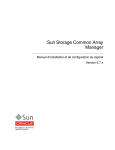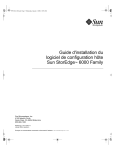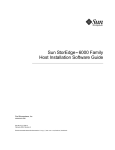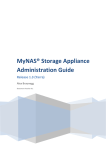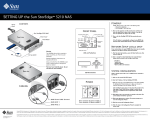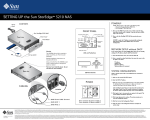Download Sun StorEdge 6920 System sscs
Transcript
Sun StorEdge™ 6920 System
sscs(1M) CLI Quick Reference Card
This document lists the sscs(1M) commands you can use to administer the Sun StorEdgeTM 6920 system from the
command-line interface (CLI).
Using the sscs Command
Task
Steps
Invoke the sscs command.
To manage the Sun StorEdge 6920 system, use the /opt/se6x20/cli/bin/sscs command.
From a terminal window, type the sscs command with a subcommand, and any required (and optional) parameters.
Note: The sscs command has an inactivity timer. The session terminates if you do not issue any sscs commands for 30 minutes.
You must log in again after the timeout to issue a command.
Display a brief list of all
subcommands.
Type one of the following commands:
sscs [-H | --help]
or
sscs -?
Display information about a
specific subcommand.
Type the following command:
sscs subcommand [-H | --help]
For example, to show information about the list subcommand, type sscs list -H
To show information specifically about the list array command, type sscs list -H array
Subcommand Syntax and Usage Conventions
Convention
Description
Bold
Text in boldface should be typed exactly as shown.
Italic
Text in italics is variable and should be replaced with the name or value used at your site. Variables can be separated by a comma
or space. Note: Spaces alone do not work in lists. The following examples show the correct use of commas and spaces in lists:
sscs list volume TestVOL,fvm13311
sscs list volume TestVol, fvm13311
Square brackets, [ ]
Text in square brackets is optional.
Vertical bar, |
Text separated by a vertical bar is exclusive. Specify only one of the options.
Braces, { }
Text inside braces is a required argument.
Short and long names
The sscs command accepts short or long names for each option. Short name options require a single hyphen (-). Long name
options require a double hyphen (--).
Special characters in names
Do not use spaces, commas, colons (:), or any of the following special characters: ?, *, !, @, %, &
General Commands
Description
Command
sscs login -u admin|storage|guest -h hostname [-f] [-t]
Log in to the system’s Storage Service Processor.
When you log in, you must specify the type of user you are
logging in as and the host name of the Storage Service
Processor. The following list describes the short and long
name command options for the login command:
-u, --username
Specifies the user name with which to log in. Valid user
names are admin, storage, and guest.
-h, --hostname
Specifies the host name of the Storage Service Processor.
-f, --force
Forces a login to the Storage Service Processor if another
storage user with the same user name is already logged
in. The other user is logged out.
-t, --http
Logs the user in using an HTTP connection.
Change the password.
sscs modify password admin|storage|guest
Log off the Storage Service Processor.
All users logged in at the same host are logged off by this
command, regardless of their sscs role.
sscs logout
Display the version of the sscs software running on the
Storage Service Processor.
sscs -V
List the software revision updates to be installed and the undo
list of the most recent updates.
sscs list [-u] revision
Uninstall a revision.
sscs remove revision
Display site information such as the system serial number and
contact information.
sscs list site
Display the system ID and description.
sscs list system
Display the current date and time in hours, minutes, and
seconds.
sscs list date
Change the date on the Storage Service Processor using the
SolarisTM date(1) command utility.
sscs modify -G true|false date [mmdd] HHMM|mmddHHMM [cc] [yy] [ .SS ]
Display the system’s current time zone.
sscs list timezone
Change the system’s time zone, using any of the time zones
supported by the JavaTM programming environment.
sscs modify timezone time-zone
List all jobs, only completed jobs, or only current jobs.
sscs list [-C] [-o] jobs [job-ID,...]
Cancel a current job or delete a historical job.
sscs modify [-k job-ID,...][-d job-ID,...] jobs
List log messages, for a range of time or for the most recent
ones.
sscs list [ [-s {[mmdd] HHMM|mmddHHMM [cc]yy} [.SS]-f
{[mmdd]HHMM|mmddHHMM [cc]yy}[.SS]][-t number-of-messages] log
Display the power status of the system.
sscs list power
Change the power mode to a partial shutdown, full shutdown,
or full power.
sscs modify power down|off|on
Change the system’s inventory of modules.
sscs modify -m model [-c validate-only][-S serial-number][-p string[-t|save-array-password]
[-T timeout-value][-d string] inventory
Set or change the country code.
sscs modify -c country-name countrycode
Rescan the system to detect additional external storage.
(Minimum version 3.0.0.)
sscs rescan system
Alarm Commands
Description
Command
List the devices that are being monitored, or list specific
information about one device.
sscs list [-n device-name] [-i IP-address] device
Display a list of alarms with date and severity, or display
specific information about one alarm.
sscs list [-s 1..3][-f device-type][-a] alarm alarm-ID,...
Delete an alarm.
sscs remove [-f device-type][-s 1..3][-A] alarm
Display the current notifications for alarms.
sscs list notification
Enable remote notification or add a new notification.
sscs add [-e email-address,...][-i IP-address,...][-t 1|2|3|4|5] [-l warning|error|down]
notification local_email|nscc_email|ssrr|trap|sae
Remove a notification, from a specific source to a specific
address, or of a specific type.
sscs remove [-e email-address,...][-i IP-address,...] notification
nscc-email|ssrr|trap|sae
Port and Network Configuration Commands
Description
Command
Display network configuration information, such as IP address
and domain name.
sscs list net
Change the system’s network parameters, such as enabling the
Data Host Control Protocol (DHCP).
sscs modify [-d on|off][-g IP-address][-n IP-address][-i IP-address][-m netmask]
[-D domain-name] net
Display information about the Network Time Protocol (NTP)
server.
sscs list ntp
Enable, change, or disable the Network Time Protocol (NTP)
server.
sscs modify [-e][-d] ntp IP-address
Display the IP address of the devices being monitored.
sscs list [-n device-name] [-i IP-address] device
Display the device name and Media Access Control (MAC)
address for each device.
sscs list ethers
Add the Ethernet address of a device to the boot table for
Reverse Address Resolution Protocol (RARP) initialization.
sscs add -n device-name -e MAC-address ethers
Delete an Ethernet address from the RARP device boot table.
sscs remove -n device-name ethers
Display all outward-facing Fibre Channel ports.
sscs list fcport
Display status and event information about a specific Fibre
Channel port.
sscs list fcport FC-port-name
Change the speed or name of a Fibre Channel port.
sscs modify -s 1GB|2GB|auto fcport FC-port-name
Display the filtering information for all firewall services or for
a specific service.
sscs list firewall_service [service,...]
Change the attributes of a firewall service.
Note: To display valid service names, use the sscs list
firewall_service [service,...] command.
sscs modify [-e|-d]firewall_service [service,...]
External Storage Commands
Description
Command
Generate details for each disk specified by the external-storage
operand. If no disk is specified, generate a summary of all
external storage disks.
sscs list externalstorage [external-storage[,...]]
Initialize an external storage disk as a virtual disk and add it to
a storage pool. (Minimum version 3.0.0.)
sscs create -e -p pool-name [-S storage-domain-name] vdisk
Create a virtualized legacy volume from an external storage
disk. (Minimum version 3.0.0.)
sscs create
-e external-storage
-p pool-name
[-d volume-description]
[-S storage-domain-name]
volume volume-name
Array, Tray, and Disk Commands
Description
Command
Display all current arrays and the summary information for
each array.
sscs list array
Display configuration information for the named array.
sscs list array [array-name,...]
Display an array’s current power status.
sscs list -a array-name arraypower
Display information about all disks in an array or tray, or
display detailed information about a specific disk.
sscs list -a array-name [-t tray-ID] disk [disk-name,...]
Display information about all the trays in an array, or display
detailed information about a specific tray.
sscs list -a array-name tray [tray-ID,...]
Change the configuration of an array.
sscs modify [-c [auto|writebehind|writethrough|off]][-d text][-h
hot-spare-drive-count] [-R[high|medium|low]] [-f[explicit|implicit|none]]
[-k enabled|disabled] array array-name
Shut down, restart, or restore the default values of an array.
sscs modify -a array-name arraypower off|restart|restore
Change the identification of a tray, enable or disable an
alternate master tray, or unconfigure a controller tray.
sscs modify -a array-name [-u|-d|-e] tray tray-ID,...
Storage Pool Commands
Description
Command
Display summary information about all current storage pools.
sscs list pool
Display detailed information about specific storage pools.
sscs list [-S storage-domain-name] pool [pool-name,...]
Create a storage pool, using either the specified profile or
values for all options. Note: If a storage domain name is not
provided, the system assigns the DEFAULT storage domain
name.
sscs create -p profile-name [-S storage-domain-name][-d pool-description] pool pool-name
Delete a storage pool, including all virtual disks and volumes
in the storage pool. Note: If a storage domain name is not
provided, the system assigns the DEFAULT storage domain
name.
sscs delete [-S storage-domain-name] pool pool-name,...
Change the description of a storage pool or its associated
storage profile.
sscs modify [-S storage-domain-name][-p new-profile-name] [-d description] pool
pool-description
Storage Domain Commands
Description
Command
Display information about a specific storage domain.
(If you do not provide a storage domain name, the system
provides a list of all storage domains on the system.)
sscs list sdomain storage-domain-name,...
Create a storage domain.
sscs create [-d storage-domain-description] sdomain storage-domain-name
Delete one or more storage domains, including the storage
pools defined for them.
sscs delete sdomain storage-domain-name,...
Change the description of a storage domain.
sscs modify -d description sdomain storage-domain-name
Storage Profile Commands
Description
Command
Display a list of all the factory storage profiles or
customer-created profiles. You can also display detailed
information for a specific profile.
sscs list profile profile-name,...
Create a storage profile.
sscs create -r 0|1|5 -t
iops|bandwidth|capacity|bm_iops|bm_bandwidth|bm_capacity
-s 4K|8K|16K|32K| 64K -h on|off -n variable|2|3|…|14 -v stripe|concat
-D yes|no [ -p 128K|512K| 1M|2M|4M|8M|16M][-d profile-description] profile profile-name
Delete one or more storage profiles, providing that no storage
pools are currently using the profile.
sscs delete profile profile-name,...
Change a storage profile, providing that no storage pools are
currently using the profile.
sscs modify [-d profile-description][-N profile-name][-r 0|1|5]
[-t iops|bandwidth|capacity|bm_iops|bm_bandwidth|bm_capacity]
[-s 4K|8K|16K|32K|64K]][-h [on|off]][-n variable|2|3|…|14]
[-v stripe|concat][-p 128K|512K|1M|2M|4M|8M|16M][ -D yes|no] profile profile-name
Initiator Commands
Description
Command
Display summary information about all current initiators.
sscs list initiator
Display a list of all initiators or detailed information for a
specific initiator.
sscs list [-S storage-domain-name] [-T name-type [WWN|initiator-name] initiator
[initiator-name,...]
Create an initiator.
sscs create -w initiator-WWN [-o standard|hpux][-S storage-domain-name]
[-d initiator-description ]initiator initiator-name
Delete one or more unmapped initiators.
sscs delete [-S storage-domain-name] initiator initiator-name,...
Change an initiator. Note: You can modify the World Wide
Name (WWN) only when the initiator is offline.
sscs modify [-d description][-o standard|hpux][-N new-initiator-name]
[-S storage-domain-name][-w initiator-WWN][-T WWN|initiator-name] initiator initiator-ID
Virtual Disk Commands
Description
Command
Display summary information about all current virtual disks or
detailed information about a specific virtual disk.
sscs list [-p pool-name] [-S storage-domain-name] [--unassigned-only]
vdisk [virtual-disk-ID,...]
Create a virtual disk and add it to a storage pool.
sscs create -p pool-name -t tray-ID -a array-name [-S storage-domain-name][-d number-of-disks]
vdisk
Delete a virtual disk or multiple virtual disks, providing they
are not in use and are assigned to the same storage pool.
sscs delete -p pool-name [-S storage-domain-name] vdisk virtual-disk-ID,...
Change a virtual disk’s storage pool, providing that no
volumes are allocated.
sscs modify -P new-pool-name [-p pool-name] vdisk virtual-disk-ID
Volume Commands
Description
Command
Display summary information about all current volumes or
detailed information about a specific volume.
sscs list [-p pool-name] [-S storage-domain-name] volume [volume-name,...]
Create a volume without snapshot reserve space.
sscs create
-p pool-name
-s size TB|GB|MB|B
[-t]
[-d volume-description]
[-S storage-domain-name]
volume volume-name
Create a volume with snapshot reserve space. (Minimum
version 3.0.0.)
sscs create
-p pool-name
-s size TB|GB|MB|B
-C 1...32
-L low|verylittle|little|average|high|full]
[-P pool-name]
[-f volume|snapshot]
[-t]
[-d volume-description]
[-S storage-domain-name]
volume volume-name
Delete one or more unmapped volumes.
sscs delete [-S storage-domain-name] volume volume-name,…
Change a volume’s attributes. (Minimum version 3.0.0.)
sscs modify
[-N new-volume-name]
[-f volume|snapshot]
[-p pool-name]
[-e extend-size MB|GB|TB|B]
[-d volume-description]
[-S storage-domain-name]
volume volume-name
Configure the snapshot reserve space for existing volume
volume-name that does not have snapshot reserve space
configured (including virtualized legacy volumes). (Minimum
version 3.0.0.)
sscs modify
-P pool
-C 1...32
-L low|verylittle|little|average|high|full
[-f volume|snapshot]
[-S storage-domain-name]
volume volume-name
Expand the snapshot reserve space for a volume (including
mirrored volumes and virtualized legacy volumes) that already
has snapshot reserve space configured. (Minimum version
3.0.0.)
sscs modify
-C 1...32
-L low|verylittle|little|average|high|full
[-S storage-domain-name]
volume volume-name
Map a volume to an initiator, or change an existing map.
sscs map -v volume-name,... -P readonly|readwrite [-S storage-domain-name]
[-l 0..255 ] initiator initiator-name
Map an initiator to a volume, or change an existing map.
sscs map initiator initiator-name -P readonly|readwrite [-S storage-domain-name]
[-l 0..255] volume volume-name,...
Unmap an initiator.
sscs unmap [-S storage-domain-name] -v volume-name,... initiator initiator-name
Unmap a volume.
sscs unmap [-S storage-domain-name] -i initiator-name... volume volume-name
Rollback snapshot snapshot-volume-name. (Minimum version
3.0.0.)
sscs snapshot
-b
[-S storage-domain-name]
volume snapshot-volume-name
Cancel rollback of snapshot snapshot-volume-name.
Warning: This operation should be used only as a last resort
because it causes the parent volume to be lost. (Minimum
version 3.0.0.)
sscs snapshot
-c
[-S storage-domain-name]
volume snapshot-volume-name
Volume Commands (continued)
Description
Command
Take a snapshot of volume (or virtualized legacy volume)
source-volume-name that does not have snapshot reserve space
configured. (Minimum version 3.0.0.)
sscs snapshot
-v source-volume-name
-P pool
-C 1...32
-L low|verylittle|little|average|high|full
[-f volume|snapshot]
[-d volume-description]
[-S storage-domain-name]
volume new-snapshot-name
Expand the snapshot reserve space and take a snapshot of
volume source-volume-name that already has snapshot reserve
space configured (includes mirrored volumes and virtualized
legacy volumes). (Minimum version 3.0.0.)
sscs snapshot
-v source-volume-name
-C 1...32
-L low|verylittle|little|average|high|full
[-f volume|snapshot]
[-d volume-description]
[-S storage-domain-name]
volume new-snapshot-name
Create a snapshot for volume source-volume-name.
sscs snapshot
-v source-volume-name
[-d volume-description]
[-S storage-domain-name]
volume new-snapshot-name
Resnap volume snapshot-volume-name. (Minimum version 3.0.0.) sscs snapshot
-R
[-S storage-domain-name]
volume snapshot-volume-name
Remove all snapshots for volume source-volume-name.
(Minimum version 3.0.0.)
sscs snapshot
-r
[-S storage-domain-name]
volume source-volume-name
Remote Replication Commands
Description
Command
Enable or disable replication for a port. (Minimum version
3.0.0.)
sscs modify [-r enable|disable] fcport fcport-name
List either a summary of all gigabit Ethernet ports or the
details of the ports specified by etherport-ID[,...]. (Minimum
version 3.0.0.)
sscs list etherport [etherport-ID [,...]]
Enable or disable replication for gigabit Ethernet port
etherport-ID. (Minimum version 3.0.0.)
sscs modify -r enable|disable [-g gateway] [-m mask] [-l local] etherport
etherport-ID
Add remote address remote-address to gigabit Ethernet port
etherport-ID. (Minimum version 3.0.0.)
sscs add -t remote-address [-d port-description] etherport etherport-ID
Remove remote address(es) from a gigabit Ethernet port.
(Minimum version 3.0.0.)
sscs remove -t remote-address[,...] etherport etherport-ID
Remote Replication Commands (continued)
Description
Command
Create a replication set outside of a replication consistency
group. (Minimum version 3.0.0.)
sscs create
-l local-volume
-w peer-wwn
-o remote-volume
-b bitmap-pool
-r primary|secondary
-m sync|async
[-R low|medium|high]
[-s enable|disable]
[-x enable|disable]
[-p enable|disable]
[-q pool]
[-Q size TB|GB|MB|B]
[-u block|suspend]
[-k blocks-count-threshold]
[-t time-threshold]
[-S storage-domain-name]
repset
Create a replication set in a new replication consistency group.
(Minimum version 3.0.0.)
sscs create
-G new-group-name
-l local-volume
-w peer-wwn
-o remote-volume
-b bitmap-pool
-r primary|secondary
-m sync|async
[-R low|medium|high]
[-d group-description]
[-s enable|disable]
[-x enable|disable]
[-p enable|disable]
[-q pool]
[-Q size TB|GB|MB|B]
[-u block|suspend]
[-k blocks-count-threshold]
[-t time-threshold]
[-S storage-domain-name]
repset
Create a replication set in an existing replication consistency
group. (Minimum version 3.0.0.)
sscs create
-g constgroup-name
-l local-volume
-o remote-volume
-b bitmap-pool
[-S storage-domain-name]
repset
List details for each replication set specified by repset-name,....
If the repset operand is left blank, generate a summary of all
replication sets. (Minimum version 3.0.0.)
sscs list [-S storage-domain-name] repset [repset-name,...]
Modify the attributes of replication set repset-name. If the
replication set is a member of a replication consistency group,
then modify all of the replication sets in the group
accordingly. (Minimum version 3.0.0.)
sscs modify
[-m sync|async]
[-r primary|secondary]
[-R low|medium|high]
[-s enable|disable]
[-x enable|disable]
[-p enable|disable]
[-q pool]
[-Q size TB|GB|MB|B]
[-u block|suspend]
[-k blocks-count-threshold]
[-t time-threshold]
[-S storage-domain-name]
repset repset-name
Place replication set repset-name in suspend mode. (Minimum
version 3.0.0.)
sscs modify
-c
[-T]
[-S storage-domain-name]
repset repset-name
Remote Replication Commands (continued)
Description
Command
Resume replicating a replication set that has been suspended, sscs modify
-z
or start replicating a replication set. (Minimum version 3.0.0.)
[-F]
[-S storage-domain-name]
repset repset-name
Delete replication set repset-name. (Minimum version 3.0.0.)
delete [-S storage-domain-name] repset repset-name
List details for each replication set specified by repset-name[,...].
If the repset operand is left blank, generate a summary of all
replication sets. (Minimum version 3.0.0.)
sscs list [-S storage-domain-name] repset [repset-name[,...]]
List the details for each replication consistency group
specified by constgroup-name. If no group is specified, list a
summary of all replication consistency groups for a storage
domain. (Minimum version 3.0.0.)
sscs list [-S storage-domain-name] constgroup [constgroup-name[,...]]
Modify the attributes of a specified replication consistency
group. All of the replication sets in the group are modified
accordingly. (Minimum version 3.0.0.)
sscs modify
[-N new-name]
[-d description]
[-m sync|async]
[-r primary|secondary]
[-R low|medium|high]
[-s enable|disable]
[-x enable|disable]
[-p enable|disable]
[-q pool]
[-Q size TB|GB|MB|B]
[-u block|scoreboard]
[-k blocks-count-threshold]
[-t time-threshold]
[-S storage-domain-name]
constgroup constgroup-name
Place replication consistency group constgroup-name in suspend
mode. All of the replication sets in the group are set to
suspend. (Minimum version 3.0.0.)
sscs modify
-c
[-T]
[-S storage-domain-name]
constgroup constgroup-name
Resume or start replicating a replication consistency group.
All of the replication sets in the group are set to replicating.
(Minimum version 3.0.0.)
sscs modify
-z
[-F]
[-S storage-domain-name]
constgroup constgroup-name
Delete replication consistency group constgroup-name.
(Minimum version 3.0.0.)
sscs delete [-S storage-domain-name] constgroup constgroup-name
Add replication set repset-name to replication consistency group
constgroup-name. (Minimum version 3.0.0.)
sscs add -r repset-name [-S storage-domain-name] constgroup constgroup-name
Remove replication set repset-name from replication
consistency group constgroup-name. (Minimum version 3.0.0.)
sscs remove -r repset-name [-S storage-domain-name] constgroup constgroup-name
Mirror Volume Commands
Description
Command
Create a new mirrored volume with up to four components.
(Minimum version 3.0.0.)
sscs create
-m pool1,pool2,[pool3],[pool4]
-s size TB|GB|MB|B
[-i required|optional]
[-d volume-description]
[-g pool-name]
[-v low|medium|high]
[-S storage-domain-name]
volume mirrored-volume-name
Create a new mirrored volume with up to four components,
and configure snapshot reserve space. (Minimum version
3.0.0.)
sscs create
-m pool1,pool2,[pool3],[pool4]
-s size TB|GB|MB|B
-P pool-name
-C 1...32
-L low|verylittle|little|average|high|full]
-T mirror-component-name
[-f volume|snapshot]
[-i required|optional]
[-d volume-description]
[-g pool-name]
[-v low|medium|high]
[-S storage-domain-name]
volume mirrored-volume-name
Mirror existing volume volume-name. The total new
components from both the component-volume and mirror-pool
options must not exceed three. (Minimum version 3.0.0.)
sscs modify
-M
[-c volume[,...]
[-m pool[,...]
[-i required|optional]
[-d volume-description]
[-g pool]
[-v low|medium|high]
[-S storage-domain-name]
volume volume-name
Add existing volume(s) volume[,...] to mirrored volume
mirrored-volume-name as a new component volume, and/or add
new components from pool(s) pool. (Minimum version 3.0.0.)
sscs add [-c volume[,...]] [-m pool[,...]] [-i required|optional][-v low|medium|high]
[-S storage-domain-name] volume mirrored-volume-name
Configure snapshot reserve mirror-component for mirrored
volume mirrored-volume-name, which does not yet have a
snapshot reserve configured. (Minimum version 3.0.0.)
sscs modify
-P pool
-C 1...32
-L low|verylittle|little|average|high|full
-T mirror-component
[-f volume|snapshot]
[-S storage-domain-name]
volume mirrored-volume-name
Take a snapshot of a mirrored volume that does not have
snapshot reserve space configured. (Minimum version 3.0.0.)
sscs snapshot
-v source-volume-name
-P pool
-C 1...32
-L low|verylittle|little|average|high|full
-T mirror-component
[-f volume|snapshot]
[-d volume-description]
[-S storage-domain-name]
volume new-snapshot-name
Split component volume component-volume-name from a
mirrored volume in storage domain storage-domain-name.
(Minimum version 3.0.0.)
sscs modify
-t
[-S storage-domain-name]
volume component-volume-name
Rejoin split component volume component-volume-name to the
mirrored volume in storage domain storage-domain-name.
(Minimum version 3.0.0.
sscs modify
-j
[-R]
[-S storage-domain-name]
volume component-volume-name
Mirror Volume Commands (continued)
Description
Command
Break component volume component-volume-name from the
mirrored volume in storage domain storage-domain-name.
(Minimum version 3.0.0.)
sscs modify
-b
[-f]
[-S storage-domain-name]
volume component-volume-name
Modify the resilver priority of mirrored volume
mirrored-volume-name in storage domain storage-domain-name.
(Minimum version 3.0.0.)
sscs modify
-v low|medium|high
[-S storage-domain-name]
volume mirrored-volume-name
Repair the mirror logs of the mirrored volume
mirrored-volume-name. (Minimum version 3.0.0).
sscs modify
-r low|medium|high
[-S storage-domain-name]
volume mirrored-volume-name
License Commands
Description
Command
Add a valid license key not previously added to the system.
(Minimum version 3.0.0.)
sscs add license license-key
Remove a valid license key previously added to the system.
(Minimum version 3.0.0.)
sscs remove license license-key
Display details of one or more license keys specified by
license-key. Each license key identified must have been
previously added to the system. If not specified, display a
summary of all license keys. (Minimum version 3.0.0.)
sscs list license [license-key[,...]]
Display the license compliance summary for all features.
(Minimum version 3.0.0.)
sscs list -c license
Accessing Sun Documentation
You can view, print, or purchase a broad selection of Sun documentation, including localized versions, at:
http://www.sun.com/documentation
Contacting Sun Technical Support
If you have technical questions about this product that are not answered in this document, go to:
http://www.sun.com/service/contacting
Sun Welcomes Your Comments
Sun is interested in improving its documentation and welcomes your comments and suggestions. You can submit your
comments by going to:
http://www.sun.com/hwdocs/feedback
Copyright 2005 Sun Microsystems, Inc. All rights reserved. Use is subject to license terms. Third-party software, including font technology, is copyrighted and licensed from Sun
suppliers. Portions may be derived from Berkeley BSD systems, licensed from U. of CA. Sun, Sun Microsystems, the Sun logo, Java, Sun StorEdge, and Solaris are trademarks or
registered trademarks of Sun Microsystems, Inc. in the U.S. and in other countries. All SPARC trademarks are used under license and are trademarks or registered trademarks of
SPARC International, Inc. in the U.S. and in other countries. U.S. Government Rights—Commercial use. Government users are subject to the Sun Microsystems, Inc. standard
license agreement and applicable provisions of the FAR and its supplements.
Copyright 2005 Sun Microsystems, Inc. Tous droits réservés. Distribué par des licences qui en restreignent l’utilisation. Le logiciel détenu par des tiers, et qui comprend la
technologie relative aux polices de caractères, est protégé par un copyright et licencié par des fournisseurs de Sun. Des parties de ce produit pourront être dérivées des systèmes
Berkeley BSD licenciés par l’Université de Californie. Sun, Sun Microsystems, le logo Sun, Java, et Solaris sont des marques de fabrique ou des marques déposées de Sun
Microsystems, Inc. aux Etats-Unis et dans d’autres pays. Toutes les marques SPARC sont utilisées sous licence et sont des marques de fabrique ou des marques déposées de
SPARC International, Inc. aux Etats-Unis et dans d’autres pays.
Sun Microsystems, Inc.
www.sun.com
Part No. 817-5228-10, Rev. B
June 2005














